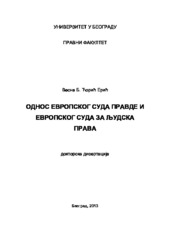Приказ основних података о дисертацији
Однос Европског суда правде и Европског суда за људска права
| dc.contributor.advisor | Rakić, Branko | |
| dc.contributor.other | Krstić, Ivana | |
| dc.contributor.other | Etinski, Rodoljub | |
| dc.contributor.other | Rakić, Branko | |
| dc.contributor.other | Krstić, Ivana | |
| dc.creator | Ćorić-Erić, Vesna B. | |
| dc.date.accessioned | 2016-01-05T12:10:41Z | |
| dc.date.available | 2016-01-05T12:10:41Z | |
| dc.date.available | 2020-07-03T09:05:09Z | |
| dc.date.issued | 2014-05-16 | |
| dc.identifier.uri | http://eteze.bg.ac.rs/application/showtheses?thesesId=1768 | |
| dc.identifier.uri | https://nardus.mpn.gov.rs/handle/123456789/2642 | |
| dc.identifier.uri | https://fedorabg.bg.ac.rs/fedora/get/o:9408/bdef:Content/download | |
| dc.identifier.uri | http://vbs.rs/scripts/cobiss?command=DISPLAY&base=70036&RID=513264561 | |
| dc.description.abstract | Питање степена усаглашености између судског система Европске уније и судског система установљеног Европском конвенцијом, као и питање избора најприкладнијег метода за изградњу ефикасног, усклађеног и целовитог система заштите људских права у Европи, поделила су у великој мери европску научну мисао и стручну јавност. Овим радом покушава се одговорити на дата питања и тиме осветлити један значајан сегмент неуређености у односима између различитих подсистема у оквиру међународног права, односно, према речима Комисије за међународно право, попунити део тзв. „црне правне рупе“. На тај начин, настоји се сузбити даљи развој европске фрагментације, која представља битан аспект проблематике фрагментације међународног права. У раду се полази од схватања Комисије за међународно право према којем извесни степен неусклађености представља неминовност, која одликује сваки правни поредак. Другим речима, потпуна усклађеност у оквиру међународноправног система још увек представља само недостижни идеал. Из датог схватања даље произилази да је, и у оквиру европског система заштите људских права, нереално тежити потпуној усаглашености између два наднационална суда. Уместо тога, ослањајући се на аргументацију коју је развила Комисија за међународно право, закључује се да су у оквиру европског система заштите људских права, оправдана једино она ограничења кохерентности која представљају непосредну последицу плуралистичког карактера система заштите људских права и која су вођена захтевима остваривања ефикасне заштите појединаца. | sr |
| dc.description.abstract | The long-standing debate about the level of coherence between the judicial system of the European Union and the judicial system established by the European Convention, as well as about the most adequate method for the establishment of efficient, coherent and comprehensive system of human right protection in Europe significantly divided scholars and other professionals. In order to illuminate this relevant segment of unregulated field of relations between different subsystems within the international law, and according to the International Law Commission, partly "fill in", the segment of alleged "legal black hole", the present thesis endeavors to answer these questions. By doing so, it is aimed at reducing the European fragmentation that constitutes an important segment of the phenomenon of the fragmentation of international law. The International Law Commission finds that the international legal system lacks sufficient level of coherence. In other words, it acknowledges that the full coherence has not been achieved so far within the international legal system. Consequently, the full coherence is also not, realistically speaking, easily achievable within the European system of human rights protection. Furthermore, the additional conclusions are drawn from the application of the reasoning of the International Law Commission to the European field. Actually, it is concluded that within the European human rights protection system are legitimate only those limitations to the coherence that stem from the pluralistic character of the human rights protection system, as well as from the demands to provide the effective protection of the individuals. Nevertheless, the conducted analysis demonstrates that there is a high level of inconsistencies between two European supranational systems of human rights protection, which should not be tolerated, as it goes beyond the indicated minimum of inconsistency, which is considered unavoidable. In other words, it exceeds the reasonable demands to provide the efficient individual protection, as well as to take into account the pluralistic character of human rights protection system in Europe. | en |
| dc.format | application/pdf | |
| dc.language | sr | |
| dc.publisher | Универзитет у Београду, Правни факултет | sr |
| dc.relation | info:eu-repo/grantAgreement/MESTD/Basic Research (BR or ON)/179031/RS// | |
| dc.rights | openAccess | en |
| dc.rights.uri | https://creativecommons.org/licenses/by/4.0/ | |
| dc.source | Универзитет у Београду | sr |
| dc.subject | Суд правде | sr |
| dc.subject | Court of Justice | en |
| dc.subject | Европски суд за људска права | sr |
| dc.subject | основна права | sr |
| dc.subject | приступање Европској конвенцији о људским правима | sr |
| dc.subject | неусаглашеност | sr |
| dc.subject | European Court of Human Rights | en |
| dc.subject | fundamental rights | en |
| dc.subject | accession to the European Convention on Human Rights | en |
| dc.subject | inconsistence | en |
| dc.title | Однос Европског суда правде и Европског суда за људска права | sr |
| dc.type | doctoralThesis | en |
| dc.rights.license | BY | |
| dcterms.abstract | Ракић, Бранко; Ракић, Бранко; Етински, Родољуб; Крстић, Ивана; Крстић, Ивана; Ћорић-Ерић, Весна Б.; Odnos Evropskog suda pravde i Evropskog suda za ljudska prava; | |
| dc.identifier.fulltext | http://nardus.mpn.gov.rs/bitstream/id/14018/Disertacija.pdf | |
| dc.identifier.fulltext | https://nardus.mpn.gov.rs/bitstream/id/14018/Disertacija.pdf | |
| dc.identifier.rcub | https://hdl.handle.net/21.15107/rcub_nardus_2642 |


